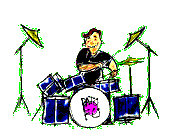
Emergent Literacy Design
Beating a Drum with B

Rationale: This lesson will help children identify /b/, the phoneme represented by B. Students will learn to recognize /b/ in spoken words by learning a memorable representation (beating a drum) and the letter symbol B, practice finding /b/ in words, and apply phoneme awareness with /b/ in phonetic cue reading by distinguishing rhyming words from beginning letters.
Materials: Primary paper and pencil; chart with “Bob and Betsy bounced on the broken bed”; drawing paper and crayons; A Bug, a Bear, and a Boy (Scholastic, 1997); word cards (or flashcards) with the words BID, BAT, BAND, FEET, and MAKE; assessment worksheet identifying pictures with /b/ (URL below)
Procedures: 1. Say: The written language we use is like a secret code. The hard and somewhat tricky part is learning what letters stand for and the mouth moves we make as we say words. Today we’re going to work on spotting the mouth move /b/. We spell /b/ with letter B. B looks like a drum stick hitting a drum when it is lowercase, and /b/ sounds like beating a drum.
2. Let’s pretend to beat a drum, /b/, /b/, /b/. [Pantomime beating drum] What are our mouths doing when we make our drum sound? Notice how we push our lips together and then blow air out with our voice box.
3. “Let me show you how to find /b/ in the word fable. I’m going to stretch the word fable out in super slow motion and listen for my drum beat. Ff-aa-blle. Slower: Ffff-aaa-bbbb-llleee. There it is! I heard the drum beat and felt my lips push together and then blow air out. I can feel the drum beat /b/ in fable.”
4. Let’s try a tongue twister [on chart]. “Bob and Betsy bounced on the broken bed.” Now lets all say it three times together. Now let’s say it again, and with this time, lets stretch the /b/ at the beginning of the words. “Bboob and Bbbetsy bbounced on the bbbroken bbbed.” Try it again, and this time break it off the word: “/b/ ob and /b/ etsy /b/ ounced on the /b/ roken /b/ ed.
5. [Have students take out primary paper and pencil.] We use letter B to spell /b/. Lowercase B looks like a drum stick hitting a drum when it is lowercase. Let’s practice writing the lowercase b. Start at the rooftop. Draw a line down passed the sidewalk to the ditch. Once you reach the ditch, come back to the sidewalk and draw a curved line (towards the right) back to the ditch so it looks like a drum (circle). Now can I see everyone’s b? After I come and give you a paw print, I want you to do 9 more just like it. Next, we are going to practice an uppercase B that looks like a drum stick with two drums. Lets practice writing the uppercase B. Draw a line down from the rooftop to the ditch. Once you reach the ditch, come back to the sidewalk and draw a curved line (towards the right) back to the ditch so it looks like a drum (circle). Next, trace your pencil back to right under the rooftop and draw a curved line (towards the right) back to the sidewalk so it looks like two drums (circles) next to the drum stick (line).
6. Call on students to answer and tell how they knew: Do you hear /b/ in book or look? Lack or back? Phone or Bone? Ball or call? Hunch or Brunch? Say: Let’s see if you can spot the mouth move /b/ in some words. Beat your drum if you hear /b/: Bill, and, Betty, baked, brown, and, yellow, bread, for, Barbara’s, baby.
7. Say: “Let’s look a fun, new book that I love. It is called A Bug, a Bear, and a Boy by David McPhail. The book is about a boy, a bear, and a bug who all are best friends, and they even read from the same book together at the same time! I am going to read you a page from the book, and I want you to listen closely.” Read pages 3-4, drawing out /b/. Ask the students if they can think of any other words with /b/. Ask them to make a silly name for the book the bug, bear, and boy are reading from like Back Behind the Beach or Belly Button Bandits. Then have each student write their silly name with invented spelling and draw a picture for the book cover. After this, hang the work up around the classroom.
8. Show BID and model how to decide if it is bid or lid: The B tells me to beat my drum, /b/, so this word is bbb-id, bid. You try some: BAT: bat or cat? BAND: band or hand? FEET: Feet or beet? MAKE: make or bake?
9. For assessment, distribute the worksheet. Students are to compete the partial spellings and color the pictures that begin with B. Call students individually to read the phonetic cue words from step #8.
Reference: Adapted from Kosh, Anna Gray. Emergent Literacy Design: Beat a Drum with B. http://agk0007.wixsite.com/annagraykoch/emergent-literacy
Assessment Worksheet: http://www.kidzone.ws/kindergarten/b-begins1.htm